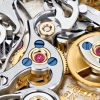Cleaning and oiling balance and jewels
-
Recently Browsing
- No registered users viewing this page.
-
Topics
-
Posts
-
By DouglasSkinner · Posted
Hello! Does anybody have this tool? This is mine. If you have one, does it look complete? How do you use it. (I have the instruction sheet but it's hard to read!) thanks! -
@JohnR725 that's very helpful. I appreciate the time you took to give those instructions and post the pictures. below is a picture of my staff, which looks identical to the ones you posted. The approx measurements I got are: .772 on the left part of the staff; .715 on the right side of the hub; the hub is 1.107; and the overall length (minus the broken pivot) is 5.248; which seem to line up with the measurements you posted. I didn't think to measure the pivot, which I'll do if there's enough of one left on the staff. Thanks again.
-
Thank you to both of you! I've been somewhat derailed by this quandary for a couple of days now. I am guessing that the point of the wider tweezers is to support the whole spring at the same time in an effort to prevent it going under tension... I have already discovered the Zen of a clutter free space, and trying to keep my work well away from the edge, however the most terrifying of the flights wasn't so short, I had my work in the middle of the table and nothing else around. That particular launch was towards me. I distinctly recall feeling the spring hit my left hand as it escaped. I only found it by dumb luck, on the floor, between the legs of my chair. I need to order a pack of replacements just in case. I think I recall a thread discussing where to find them, and the differences between the clones and the authentic ETA ones, pointing out that they're not interchangeable (the clones being longer IIRC). Now I just have to find that thread again. What I haven't mastered is the zen of the search function here. I'm sure I"ll get that down eventually. So this is similar to, but different from one of the posts I had found in my original searches (or maybe I'm just hallucinating, I can't find the post I thought I remember). The bits about the corner filled in a gap in what I'd read before. At least I have a more clear picture in my head about what needs to happen now. Yes, I've learned about how touchy these springs are. What I'm not sure I have a good grasp on is the understanding of what causes the spring to flex, other than to say "the slightest little touch" I think I'm going to try a small bit of Rodico to position the spring next time.
-
Hi all, needing a little help. I have an old Casio AQ-321G, but have no idea what battery it takes. I've looked around online, but cannot see anything... I see a 309 stamped on the case back, could this be it....? Can you please help, below are some pictures:
-







Recommended Posts
Join the conversation
You can post now and register later. If you have an account, sign in now to post with your account.
Note: Your post will require moderator approval before it will be visible.